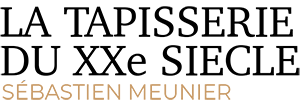Waistcoat l'enfant aux mirages (child with mirages)
Aubusson tapestry woven by the Legoueix workshop.
1997.
Provenance : Sautour-Gaillard workshop
A pupil of Wogensky at the Ecole Nationale Supérieure des Arts Appliqués, Sautour-Gaillard had his first cartoon woven in 1971 by the Legoueix workshop (a collaboration which was to last), and from then on he designed many very large-scale projects of which the most spectacular was “Pour un certain idéal” a series of 17 tapestries dealing with the theme of Olympianism (property of the Musée de l’Olympisme in Lausanne). If at first close to lyrical abstraction, the artist produced in the 1990’s cartoons superimposing different decorative motifs, textures and figures whose unity originated in the woven texture itself.
The 2 waistcoats from the exhibition « Archéologies » which was held at the Inard gallery in 1997, are evidence of the wish expressed at the period by people from Aubusson, which was going through difficult times, to widen their activity : Sautour-Gaillard, who was himself an enthusiastic collector of fabrics, reveals here the same inspiration as in his contemporary woven collages.
Bibliography :
D. Cavelier, Jean-René Sautour-Gaillard, la déchirure, Lelivredart, 2013, ill. p.6, (worn by the artist) 296


